Content Analysis: IT Service Management and Professional Culture
VerifiedAdded on 2023/03/31
|10
|2040
|400
Report
AI Summary
This report presents a comprehensive content analysis of IT Service Management and Professional Culture, based on the provided lecture materials. It covers key topics such as ITIL, best practices, and the ITIL framework, along with detailed discussions of the service lifecycle including governance, risk management, service strategy, design, and transition. The report further explores service operation, continual service improvement, and business relationship management, highlighting the four balances of service operation and the functions within. Financial management for IT services, demand management, capacity management, IT service continuity management, information security management, problem management, and the seven-step improvement process are also analyzed. The report concludes with an examination of measurement, metrics, and the Deming cycle, providing a thorough overview of the subject matter.
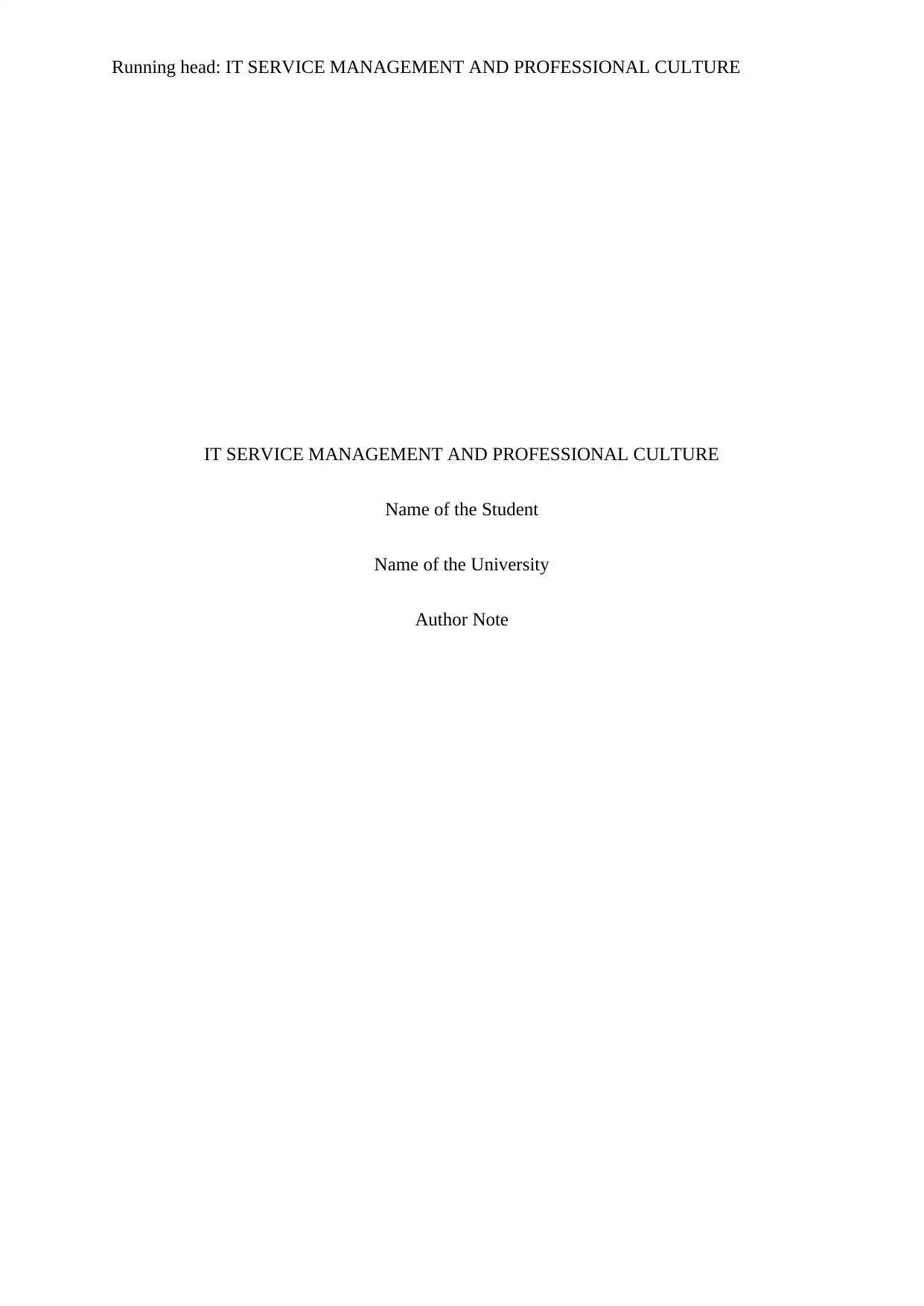
Running head: IT SERVICE MANAGEMENT AND PROFESSIONAL CULTURE
IT SERVICE MANAGEMENT AND PROFESSIONAL CULTURE
Name of the Student
Name of the University
Author Note
IT SERVICE MANAGEMENT AND PROFESSIONAL CULTURE
Name of the Student
Name of the University
Author Note
Paraphrase This Document
Need a fresh take? Get an instant paraphrase of this document with our AI Paraphraser
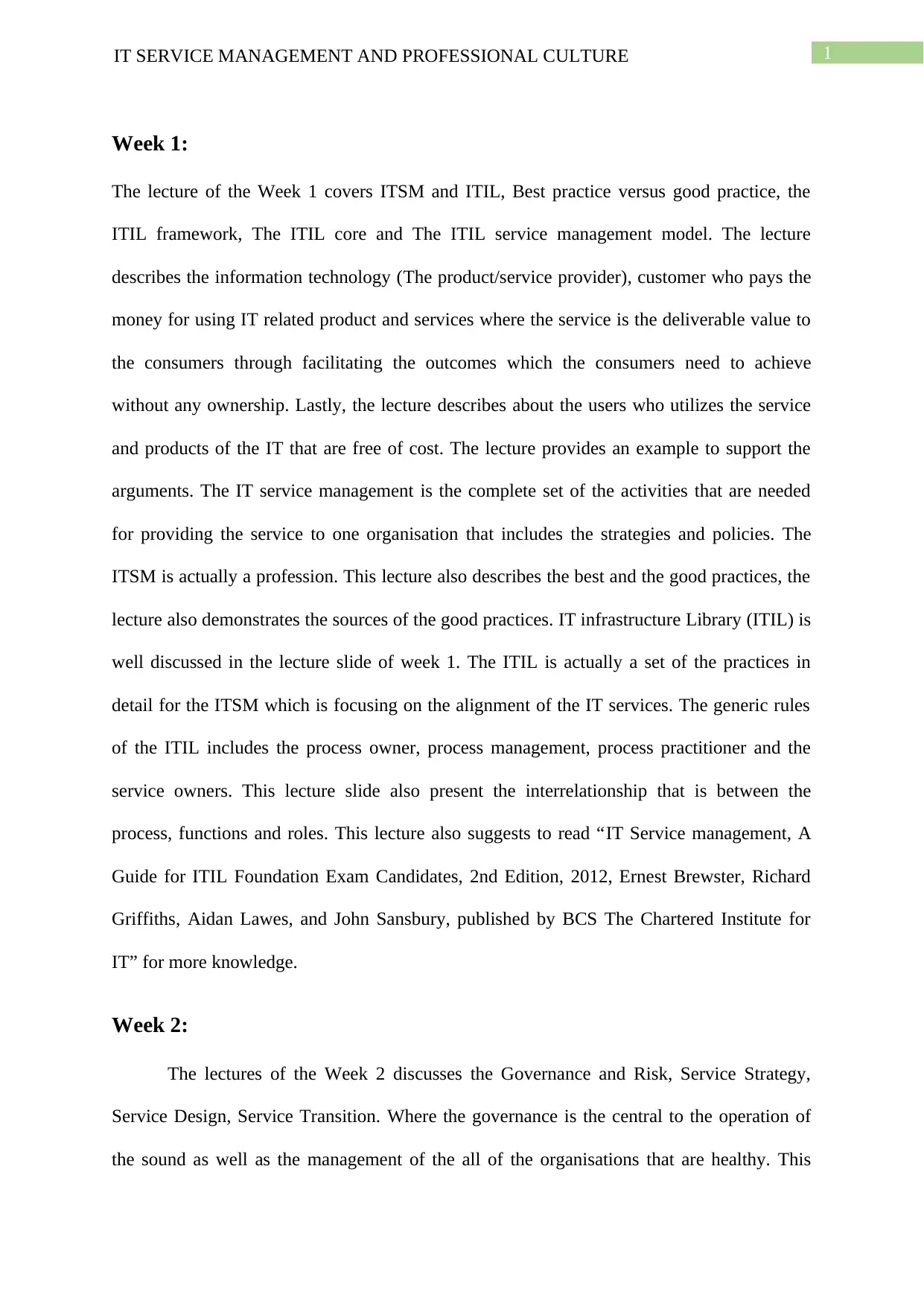
IT SERVICE MANAGEMENT AND PROFESSIONAL CULTURE 1
Week 1:
The lecture of the Week 1 covers ITSM and ITIL, Best practice versus good practice, the
ITIL framework, The ITIL core and The ITIL service management model. The lecture
describes the information technology (The product/service provider), customer who pays the
money for using IT related product and services where the service is the deliverable value to
the consumers through facilitating the outcomes which the consumers need to achieve
without any ownership. Lastly, the lecture describes about the users who utilizes the service
and products of the IT that are free of cost. The lecture provides an example to support the
arguments. The IT service management is the complete set of the activities that are needed
for providing the service to one organisation that includes the strategies and policies. The
ITSM is actually a profession. This lecture also describes the best and the good practices, the
lecture also demonstrates the sources of the good practices. IT infrastructure Library (ITIL) is
well discussed in the lecture slide of week 1. The ITIL is actually a set of the practices in
detail for the ITSM which is focusing on the alignment of the IT services. The generic rules
of the ITIL includes the process owner, process management, process practitioner and the
service owners. This lecture slide also present the interrelationship that is between the
process, functions and roles. This lecture also suggests to read “IT Service management, A
Guide for ITIL Foundation Exam Candidates, 2nd Edition, 2012, Ernest Brewster, Richard
Griffiths, Aidan Lawes, and John Sansbury, published by BCS The Chartered Institute for
IT” for more knowledge.
Week 2:
The lectures of the Week 2 discusses the Governance and Risk, Service Strategy,
Service Design, Service Transition. Where the governance is the central to the operation of
the sound as well as the management of the all of the organisations that are healthy. This
Week 1:
The lecture of the Week 1 covers ITSM and ITIL, Best practice versus good practice, the
ITIL framework, The ITIL core and The ITIL service management model. The lecture
describes the information technology (The product/service provider), customer who pays the
money for using IT related product and services where the service is the deliverable value to
the consumers through facilitating the outcomes which the consumers need to achieve
without any ownership. Lastly, the lecture describes about the users who utilizes the service
and products of the IT that are free of cost. The lecture provides an example to support the
arguments. The IT service management is the complete set of the activities that are needed
for providing the service to one organisation that includes the strategies and policies. The
ITSM is actually a profession. This lecture also describes the best and the good practices, the
lecture also demonstrates the sources of the good practices. IT infrastructure Library (ITIL) is
well discussed in the lecture slide of week 1. The ITIL is actually a set of the practices in
detail for the ITSM which is focusing on the alignment of the IT services. The generic rules
of the ITIL includes the process owner, process management, process practitioner and the
service owners. This lecture slide also present the interrelationship that is between the
process, functions and roles. This lecture also suggests to read “IT Service management, A
Guide for ITIL Foundation Exam Candidates, 2nd Edition, 2012, Ernest Brewster, Richard
Griffiths, Aidan Lawes, and John Sansbury, published by BCS The Chartered Institute for
IT” for more knowledge.
Week 2:
The lectures of the Week 2 discusses the Governance and Risk, Service Strategy,
Service Design, Service Transition. Where the governance is the central to the operation of
the sound as well as the management of the all of the organisations that are healthy. This
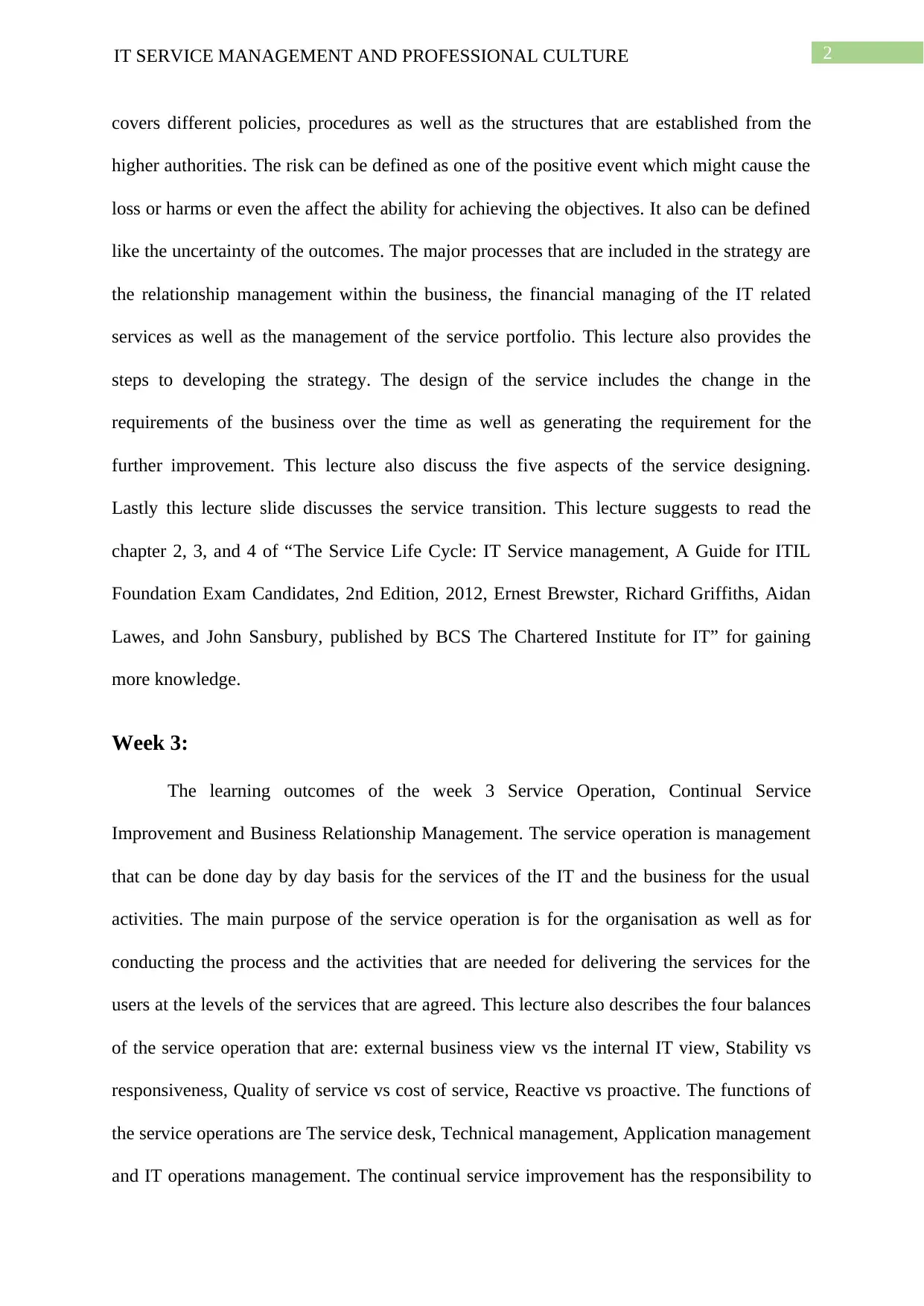
2IT SERVICE MANAGEMENT AND PROFESSIONAL CULTURE
covers different policies, procedures as well as the structures that are established from the
higher authorities. The risk can be defined as one of the positive event which might cause the
loss or harms or even the affect the ability for achieving the objectives. It also can be defined
like the uncertainty of the outcomes. The major processes that are included in the strategy are
the relationship management within the business, the financial managing of the IT related
services as well as the management of the service portfolio. This lecture also provides the
steps to developing the strategy. The design of the service includes the change in the
requirements of the business over the time as well as generating the requirement for the
further improvement. This lecture also discuss the five aspects of the service designing.
Lastly this lecture slide discusses the service transition. This lecture suggests to read the
chapter 2, 3, and 4 of “The Service Life Cycle: IT Service management, A Guide for ITIL
Foundation Exam Candidates, 2nd Edition, 2012, Ernest Brewster, Richard Griffiths, Aidan
Lawes, and John Sansbury, published by BCS The Chartered Institute for IT” for gaining
more knowledge.
Week 3:
The learning outcomes of the week 3 Service Operation, Continual Service
Improvement and Business Relationship Management. The service operation is management
that can be done day by day basis for the services of the IT and the business for the usual
activities. The main purpose of the service operation is for the organisation as well as for
conducting the process and the activities that are needed for delivering the services for the
users at the levels of the services that are agreed. This lecture also describes the four balances
of the service operation that are: external business view vs the internal IT view, Stability vs
responsiveness, Quality of service vs cost of service, Reactive vs proactive. The functions of
the service operations are The service desk, Technical management, Application management
and IT operations management. The continual service improvement has the responsibility to
covers different policies, procedures as well as the structures that are established from the
higher authorities. The risk can be defined as one of the positive event which might cause the
loss or harms or even the affect the ability for achieving the objectives. It also can be defined
like the uncertainty of the outcomes. The major processes that are included in the strategy are
the relationship management within the business, the financial managing of the IT related
services as well as the management of the service portfolio. This lecture also provides the
steps to developing the strategy. The design of the service includes the change in the
requirements of the business over the time as well as generating the requirement for the
further improvement. This lecture also discuss the five aspects of the service designing.
Lastly this lecture slide discusses the service transition. This lecture suggests to read the
chapter 2, 3, and 4 of “The Service Life Cycle: IT Service management, A Guide for ITIL
Foundation Exam Candidates, 2nd Edition, 2012, Ernest Brewster, Richard Griffiths, Aidan
Lawes, and John Sansbury, published by BCS The Chartered Institute for IT” for gaining
more knowledge.
Week 3:
The learning outcomes of the week 3 Service Operation, Continual Service
Improvement and Business Relationship Management. The service operation is management
that can be done day by day basis for the services of the IT and the business for the usual
activities. The main purpose of the service operation is for the organisation as well as for
conducting the process and the activities that are needed for delivering the services for the
users at the levels of the services that are agreed. This lecture also describes the four balances
of the service operation that are: external business view vs the internal IT view, Stability vs
responsiveness, Quality of service vs cost of service, Reactive vs proactive. The functions of
the service operations are The service desk, Technical management, Application management
and IT operations management. The continual service improvement has the responsibility to
⊘ This is a preview!⊘
Do you want full access?
Subscribe today to unlock all pages.

Trusted by 1+ million students worldwide
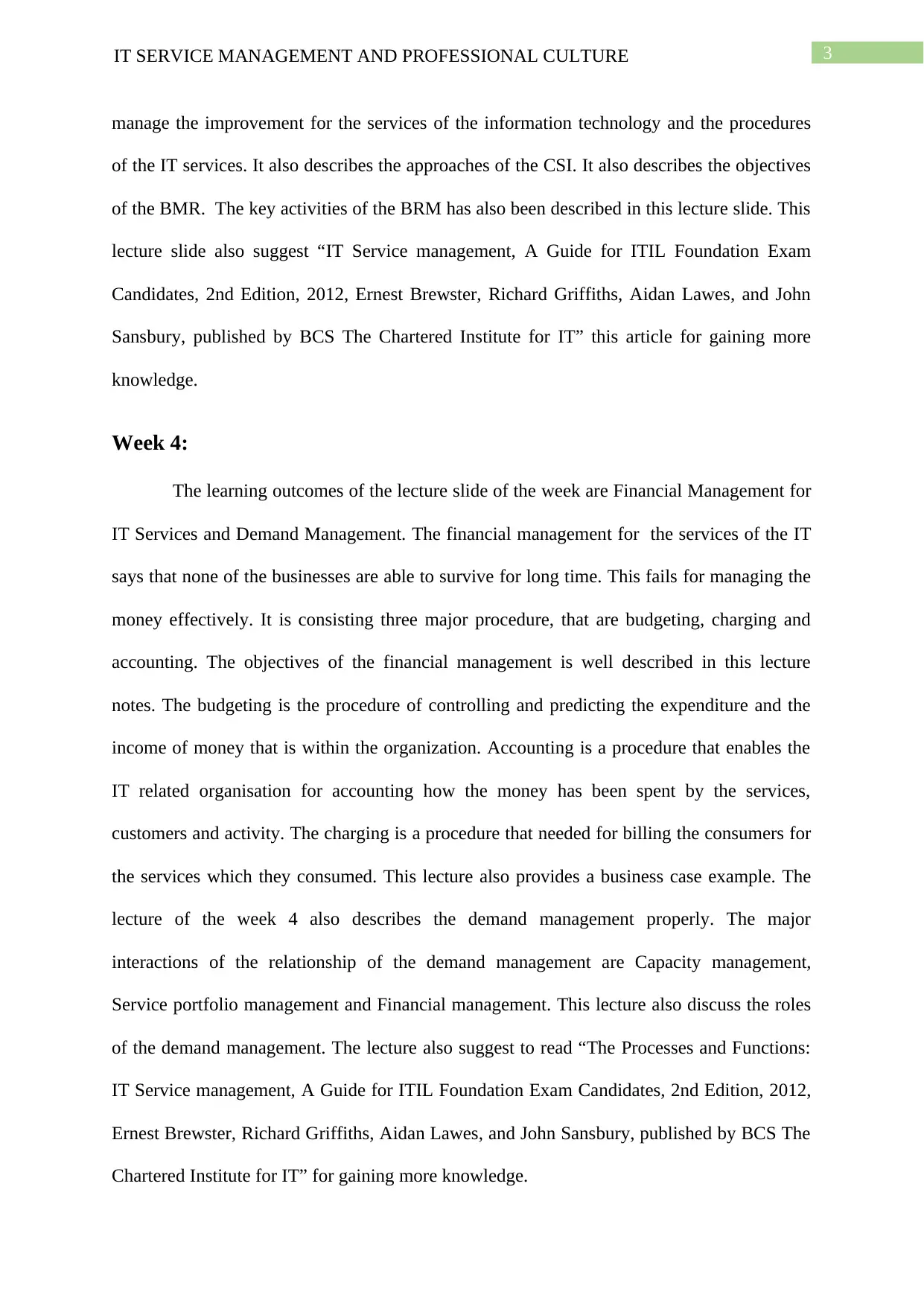
3IT SERVICE MANAGEMENT AND PROFESSIONAL CULTURE
manage the improvement for the services of the information technology and the procedures
of the IT services. It also describes the approaches of the CSI. It also describes the objectives
of the BMR. The key activities of the BRM has also been described in this lecture slide. This
lecture slide also suggest “IT Service management, A Guide for ITIL Foundation Exam
Candidates, 2nd Edition, 2012, Ernest Brewster, Richard Griffiths, Aidan Lawes, and John
Sansbury, published by BCS The Chartered Institute for IT” this article for gaining more
knowledge.
Week 4:
The learning outcomes of the lecture slide of the week are Financial Management for
IT Services and Demand Management. The financial management for the services of the IT
says that none of the businesses are able to survive for long time. This fails for managing the
money effectively. It is consisting three major procedure, that are budgeting, charging and
accounting. The objectives of the financial management is well described in this lecture
notes. The budgeting is the procedure of controlling and predicting the expenditure and the
income of money that is within the organization. Accounting is a procedure that enables the
IT related organisation for accounting how the money has been spent by the services,
customers and activity. The charging is a procedure that needed for billing the consumers for
the services which they consumed. This lecture also provides a business case example. The
lecture of the week 4 also describes the demand management properly. The major
interactions of the relationship of the demand management are Capacity management,
Service portfolio management and Financial management. This lecture also discuss the roles
of the demand management. The lecture also suggest to read “The Processes and Functions:
IT Service management, A Guide for ITIL Foundation Exam Candidates, 2nd Edition, 2012,
Ernest Brewster, Richard Griffiths, Aidan Lawes, and John Sansbury, published by BCS The
Chartered Institute for IT” for gaining more knowledge.
manage the improvement for the services of the information technology and the procedures
of the IT services. It also describes the approaches of the CSI. It also describes the objectives
of the BMR. The key activities of the BRM has also been described in this lecture slide. This
lecture slide also suggest “IT Service management, A Guide for ITIL Foundation Exam
Candidates, 2nd Edition, 2012, Ernest Brewster, Richard Griffiths, Aidan Lawes, and John
Sansbury, published by BCS The Chartered Institute for IT” this article for gaining more
knowledge.
Week 4:
The learning outcomes of the lecture slide of the week are Financial Management for
IT Services and Demand Management. The financial management for the services of the IT
says that none of the businesses are able to survive for long time. This fails for managing the
money effectively. It is consisting three major procedure, that are budgeting, charging and
accounting. The objectives of the financial management is well described in this lecture
notes. The budgeting is the procedure of controlling and predicting the expenditure and the
income of money that is within the organization. Accounting is a procedure that enables the
IT related organisation for accounting how the money has been spent by the services,
customers and activity. The charging is a procedure that needed for billing the consumers for
the services which they consumed. This lecture also provides a business case example. The
lecture of the week 4 also describes the demand management properly. The major
interactions of the relationship of the demand management are Capacity management,
Service portfolio management and Financial management. This lecture also discuss the roles
of the demand management. The lecture also suggest to read “The Processes and Functions:
IT Service management, A Guide for ITIL Foundation Exam Candidates, 2nd Edition, 2012,
Ernest Brewster, Richard Griffiths, Aidan Lawes, and John Sansbury, published by BCS The
Chartered Institute for IT” for gaining more knowledge.
Paraphrase This Document
Need a fresh take? Get an instant paraphrase of this document with our AI Paraphraser
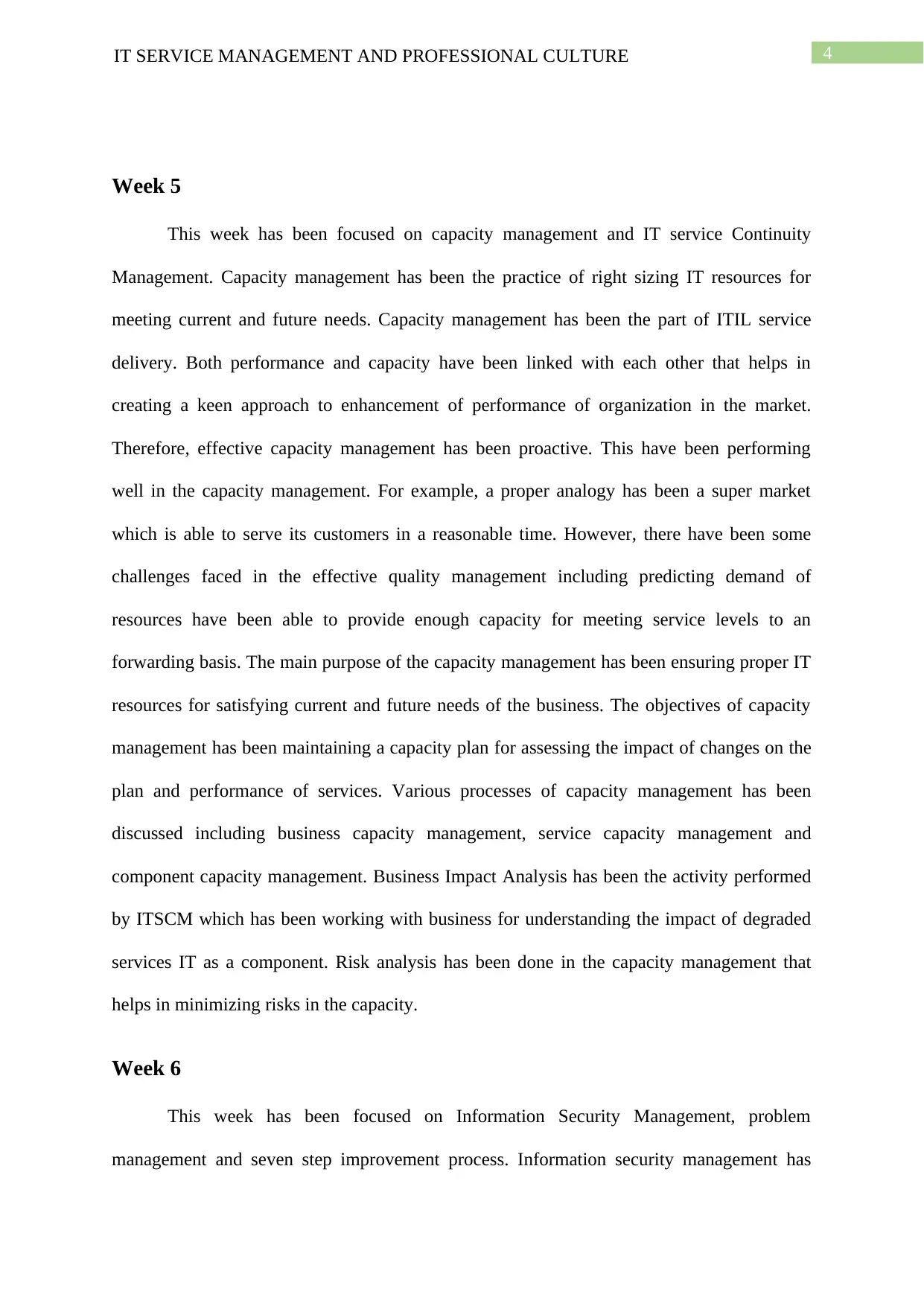
4IT SERVICE MANAGEMENT AND PROFESSIONAL CULTURE
Week 5
This week has been focused on capacity management and IT service Continuity
Management. Capacity management has been the practice of right sizing IT resources for
meeting current and future needs. Capacity management has been the part of ITIL service
delivery. Both performance and capacity have been linked with each other that helps in
creating a keen approach to enhancement of performance of organization in the market.
Therefore, effective capacity management has been proactive. This have been performing
well in the capacity management. For example, a proper analogy has been a super market
which is able to serve its customers in a reasonable time. However, there have been some
challenges faced in the effective quality management including predicting demand of
resources have been able to provide enough capacity for meeting service levels to an
forwarding basis. The main purpose of the capacity management has been ensuring proper IT
resources for satisfying current and future needs of the business. The objectives of capacity
management has been maintaining a capacity plan for assessing the impact of changes on the
plan and performance of services. Various processes of capacity management has been
discussed including business capacity management, service capacity management and
component capacity management. Business Impact Analysis has been the activity performed
by ITSCM which has been working with business for understanding the impact of degraded
services IT as a component. Risk analysis has been done in the capacity management that
helps in minimizing risks in the capacity.
Week 6
This week has been focused on Information Security Management, problem
management and seven step improvement process. Information security management has
Week 5
This week has been focused on capacity management and IT service Continuity
Management. Capacity management has been the practice of right sizing IT resources for
meeting current and future needs. Capacity management has been the part of ITIL service
delivery. Both performance and capacity have been linked with each other that helps in
creating a keen approach to enhancement of performance of organization in the market.
Therefore, effective capacity management has been proactive. This have been performing
well in the capacity management. For example, a proper analogy has been a super market
which is able to serve its customers in a reasonable time. However, there have been some
challenges faced in the effective quality management including predicting demand of
resources have been able to provide enough capacity for meeting service levels to an
forwarding basis. The main purpose of the capacity management has been ensuring proper IT
resources for satisfying current and future needs of the business. The objectives of capacity
management has been maintaining a capacity plan for assessing the impact of changes on the
plan and performance of services. Various processes of capacity management has been
discussed including business capacity management, service capacity management and
component capacity management. Business Impact Analysis has been the activity performed
by ITSCM which has been working with business for understanding the impact of degraded
services IT as a component. Risk analysis has been done in the capacity management that
helps in minimizing risks in the capacity.
Week 6
This week has been focused on Information Security Management, problem
management and seven step improvement process. Information security management has
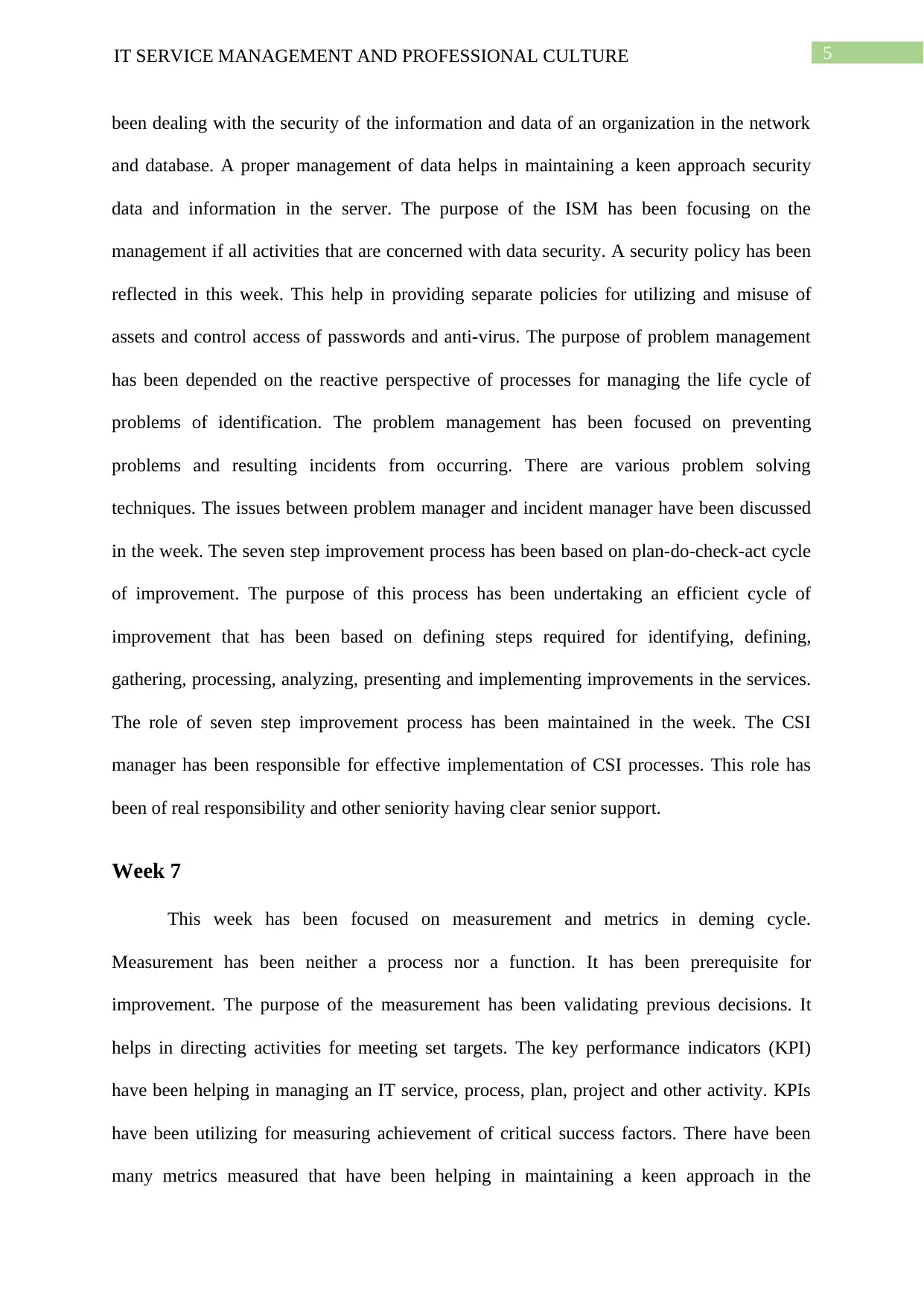
5IT SERVICE MANAGEMENT AND PROFESSIONAL CULTURE
been dealing with the security of the information and data of an organization in the network
and database. A proper management of data helps in maintaining a keen approach security
data and information in the server. The purpose of the ISM has been focusing on the
management if all activities that are concerned with data security. A security policy has been
reflected in this week. This help in providing separate policies for utilizing and misuse of
assets and control access of passwords and anti-virus. The purpose of problem management
has been depended on the reactive perspective of processes for managing the life cycle of
problems of identification. The problem management has been focused on preventing
problems and resulting incidents from occurring. There are various problem solving
techniques. The issues between problem manager and incident manager have been discussed
in the week. The seven step improvement process has been based on plan-do-check-act cycle
of improvement. The purpose of this process has been undertaking an efficient cycle of
improvement that has been based on defining steps required for identifying, defining,
gathering, processing, analyzing, presenting and implementing improvements in the services.
The role of seven step improvement process has been maintained in the week. The CSI
manager has been responsible for effective implementation of CSI processes. This role has
been of real responsibility and other seniority having clear senior support.
Week 7
This week has been focused on measurement and metrics in deming cycle.
Measurement has been neither a process nor a function. It has been prerequisite for
improvement. The purpose of the measurement has been validating previous decisions. It
helps in directing activities for meeting set targets. The key performance indicators (KPI)
have been helping in managing an IT service, process, plan, project and other activity. KPIs
have been utilizing for measuring achievement of critical success factors. There have been
many metrics measured that have been helping in maintaining a keen approach in the
been dealing with the security of the information and data of an organization in the network
and database. A proper management of data helps in maintaining a keen approach security
data and information in the server. The purpose of the ISM has been focusing on the
management if all activities that are concerned with data security. A security policy has been
reflected in this week. This help in providing separate policies for utilizing and misuse of
assets and control access of passwords and anti-virus. The purpose of problem management
has been depended on the reactive perspective of processes for managing the life cycle of
problems of identification. The problem management has been focused on preventing
problems and resulting incidents from occurring. There are various problem solving
techniques. The issues between problem manager and incident manager have been discussed
in the week. The seven step improvement process has been based on plan-do-check-act cycle
of improvement. The purpose of this process has been undertaking an efficient cycle of
improvement that has been based on defining steps required for identifying, defining,
gathering, processing, analyzing, presenting and implementing improvements in the services.
The role of seven step improvement process has been maintained in the week. The CSI
manager has been responsible for effective implementation of CSI processes. This role has
been of real responsibility and other seniority having clear senior support.
Week 7
This week has been focused on measurement and metrics in deming cycle.
Measurement has been neither a process nor a function. It has been prerequisite for
improvement. The purpose of the measurement has been validating previous decisions. It
helps in directing activities for meeting set targets. The key performance indicators (KPI)
have been helping in managing an IT service, process, plan, project and other activity. KPIs
have been utilizing for measuring achievement of critical success factors. There have been
many metrics measured that have been helping in maintaining a keen approach in the
⊘ This is a preview!⊘
Do you want full access?
Subscribe today to unlock all pages.

Trusted by 1+ million students worldwide
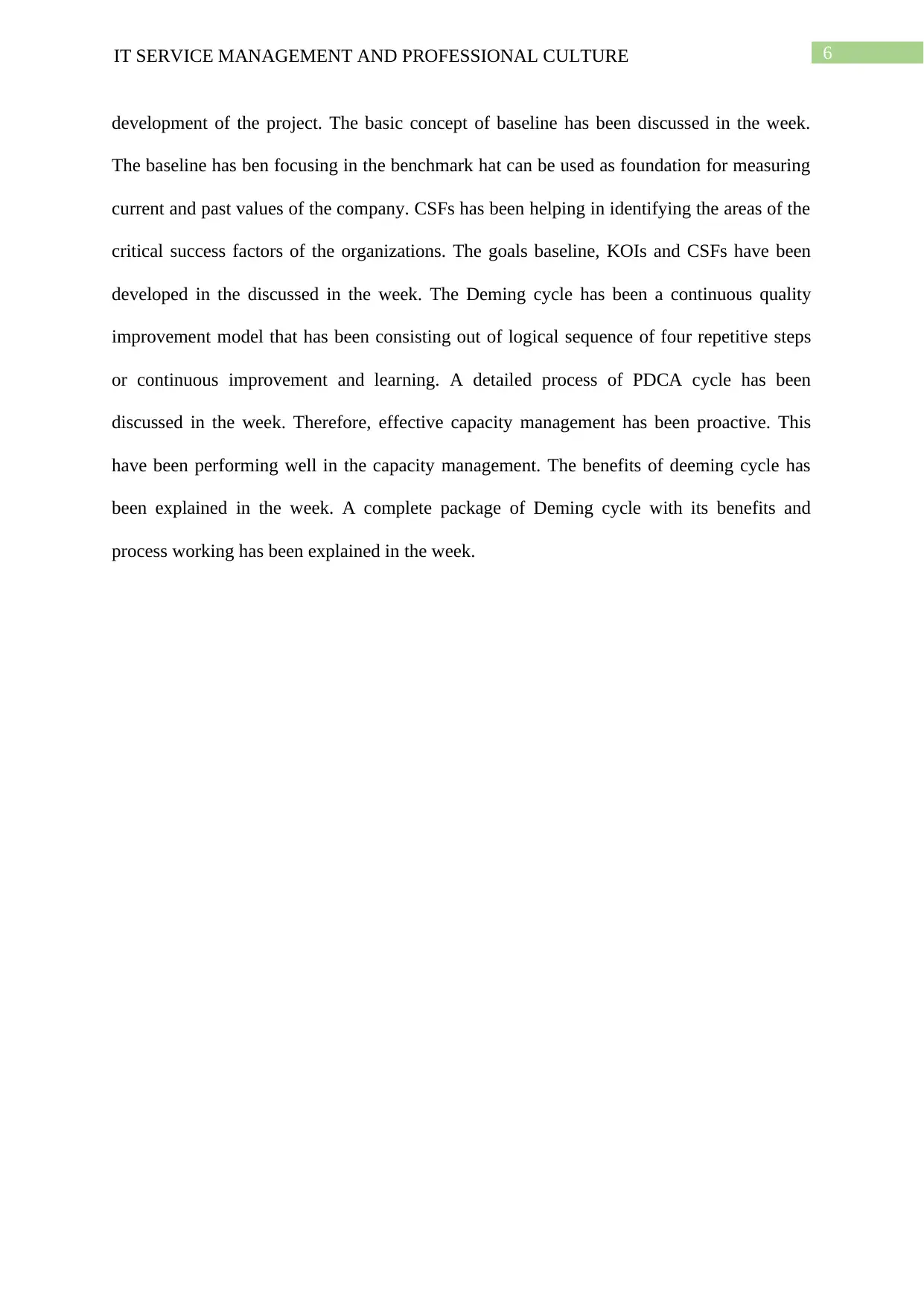
6IT SERVICE MANAGEMENT AND PROFESSIONAL CULTURE
development of the project. The basic concept of baseline has been discussed in the week.
The baseline has ben focusing in the benchmark hat can be used as foundation for measuring
current and past values of the company. CSFs has been helping in identifying the areas of the
critical success factors of the organizations. The goals baseline, KOIs and CSFs have been
developed in the discussed in the week. The Deming cycle has been a continuous quality
improvement model that has been consisting out of logical sequence of four repetitive steps
or continuous improvement and learning. A detailed process of PDCA cycle has been
discussed in the week. Therefore, effective capacity management has been proactive. This
have been performing well in the capacity management. The benefits of deeming cycle has
been explained in the week. A complete package of Deming cycle with its benefits and
process working has been explained in the week.
development of the project. The basic concept of baseline has been discussed in the week.
The baseline has ben focusing in the benchmark hat can be used as foundation for measuring
current and past values of the company. CSFs has been helping in identifying the areas of the
critical success factors of the organizations. The goals baseline, KOIs and CSFs have been
developed in the discussed in the week. The Deming cycle has been a continuous quality
improvement model that has been consisting out of logical sequence of four repetitive steps
or continuous improvement and learning. A detailed process of PDCA cycle has been
discussed in the week. Therefore, effective capacity management has been proactive. This
have been performing well in the capacity management. The benefits of deeming cycle has
been explained in the week. A complete package of Deming cycle with its benefits and
process working has been explained in the week.
Paraphrase This Document
Need a fresh take? Get an instant paraphrase of this document with our AI Paraphraser
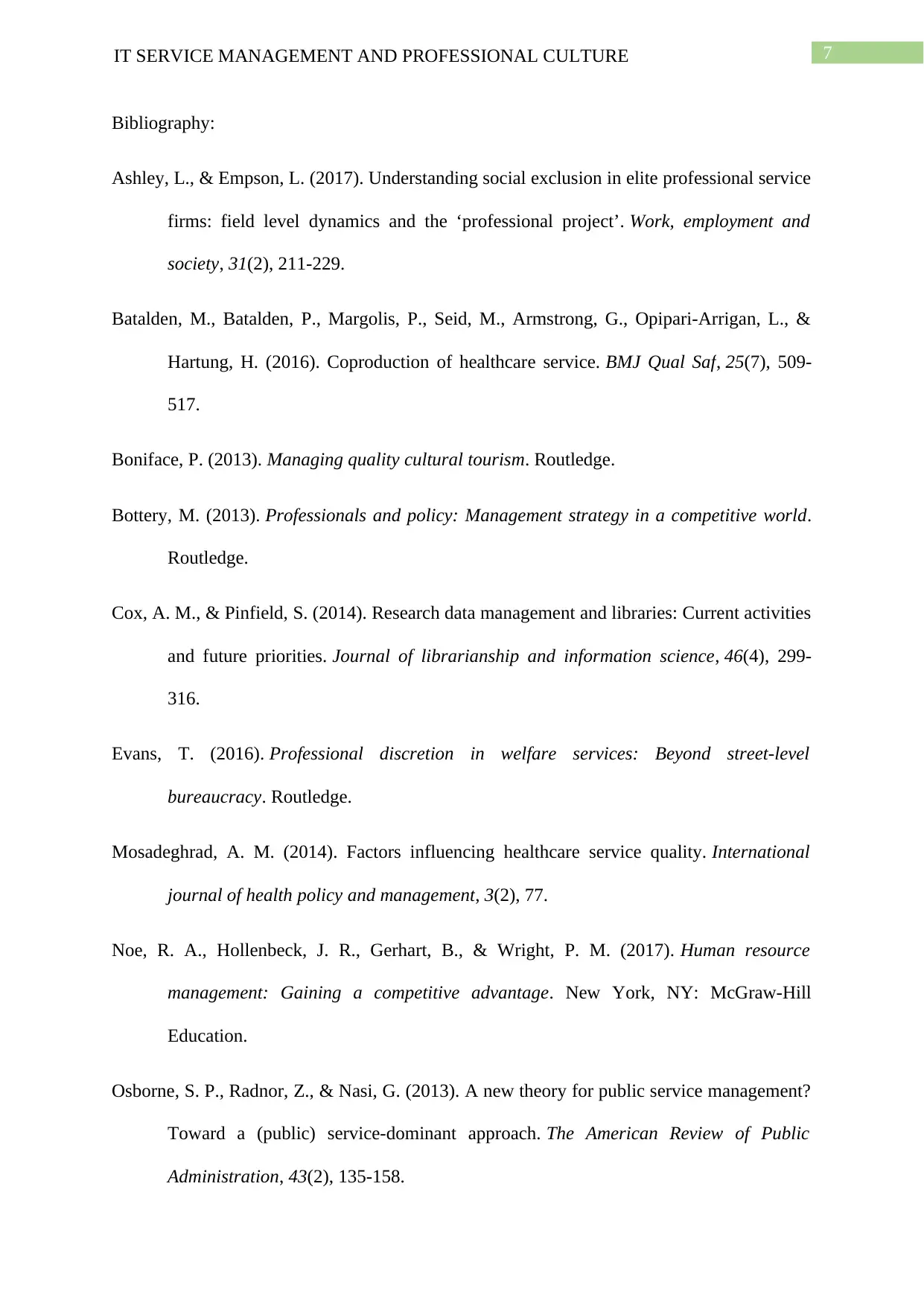
7IT SERVICE MANAGEMENT AND PROFESSIONAL CULTURE
Bibliography:
Ashley, L., & Empson, L. (2017). Understanding social exclusion in elite professional service
firms: field level dynamics and the ‘professional project’. Work, employment and
society, 31(2), 211-229.
Batalden, M., Batalden, P., Margolis, P., Seid, M., Armstrong, G., Opipari-Arrigan, L., &
Hartung, H. (2016). Coproduction of healthcare service. BMJ Qual Saf, 25(7), 509-
517.
Boniface, P. (2013). Managing quality cultural tourism. Routledge.
Bottery, M. (2013). Professionals and policy: Management strategy in a competitive world.
Routledge.
Cox, A. M., & Pinfield, S. (2014). Research data management and libraries: Current activities
and future priorities. Journal of librarianship and information science, 46(4), 299-
316.
Evans, T. (2016). Professional discretion in welfare services: Beyond street-level
bureaucracy. Routledge.
Mosadeghrad, A. M. (2014). Factors influencing healthcare service quality. International
journal of health policy and management, 3(2), 77.
Noe, R. A., Hollenbeck, J. R., Gerhart, B., & Wright, P. M. (2017). Human resource
management: Gaining a competitive advantage. New York, NY: McGraw-Hill
Education.
Osborne, S. P., Radnor, Z., & Nasi, G. (2013). A new theory for public service management?
Toward a (public) service-dominant approach. The American Review of Public
Administration, 43(2), 135-158.
Bibliography:
Ashley, L., & Empson, L. (2017). Understanding social exclusion in elite professional service
firms: field level dynamics and the ‘professional project’. Work, employment and
society, 31(2), 211-229.
Batalden, M., Batalden, P., Margolis, P., Seid, M., Armstrong, G., Opipari-Arrigan, L., &
Hartung, H. (2016). Coproduction of healthcare service. BMJ Qual Saf, 25(7), 509-
517.
Boniface, P. (2013). Managing quality cultural tourism. Routledge.
Bottery, M. (2013). Professionals and policy: Management strategy in a competitive world.
Routledge.
Cox, A. M., & Pinfield, S. (2014). Research data management and libraries: Current activities
and future priorities. Journal of librarianship and information science, 46(4), 299-
316.
Evans, T. (2016). Professional discretion in welfare services: Beyond street-level
bureaucracy. Routledge.
Mosadeghrad, A. M. (2014). Factors influencing healthcare service quality. International
journal of health policy and management, 3(2), 77.
Noe, R. A., Hollenbeck, J. R., Gerhart, B., & Wright, P. M. (2017). Human resource
management: Gaining a competitive advantage. New York, NY: McGraw-Hill
Education.
Osborne, S. P., Radnor, Z., & Nasi, G. (2013). A new theory for public service management?
Toward a (public) service-dominant approach. The American Review of Public
Administration, 43(2), 135-158.
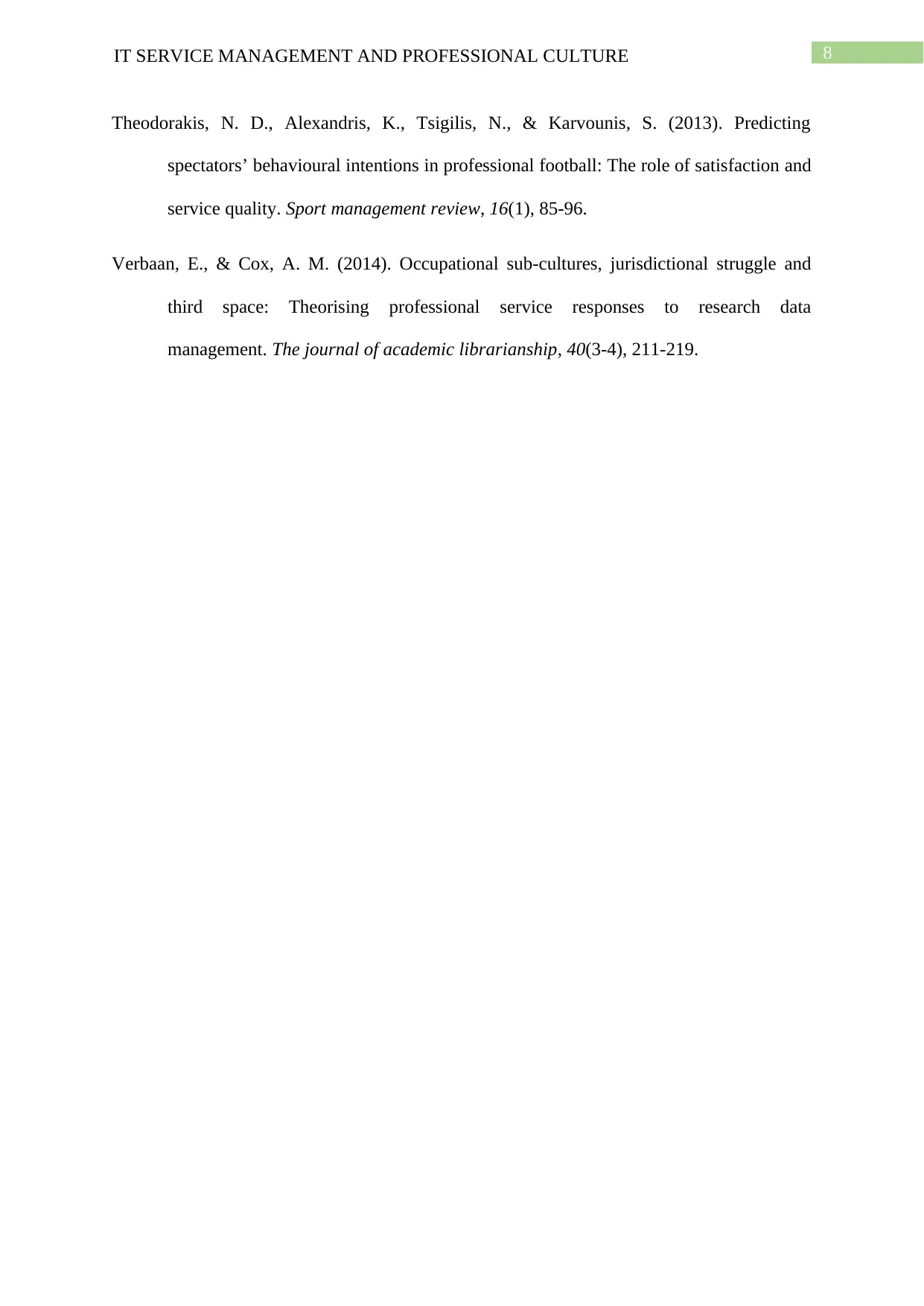
8IT SERVICE MANAGEMENT AND PROFESSIONAL CULTURE
Theodorakis, N. D., Alexandris, K., Tsigilis, N., & Karvounis, S. (2013). Predicting
spectators’ behavioural intentions in professional football: The role of satisfaction and
service quality. Sport management review, 16(1), 85-96.
Verbaan, E., & Cox, A. M. (2014). Occupational sub-cultures, jurisdictional struggle and
third space: Theorising professional service responses to research data
management. The journal of academic librarianship, 40(3-4), 211-219.
Theodorakis, N. D., Alexandris, K., Tsigilis, N., & Karvounis, S. (2013). Predicting
spectators’ behavioural intentions in professional football: The role of satisfaction and
service quality. Sport management review, 16(1), 85-96.
Verbaan, E., & Cox, A. M. (2014). Occupational sub-cultures, jurisdictional struggle and
third space: Theorising professional service responses to research data
management. The journal of academic librarianship, 40(3-4), 211-219.
⊘ This is a preview!⊘
Do you want full access?
Subscribe today to unlock all pages.

Trusted by 1+ million students worldwide

9IT SERVICE MANAGEMENT AND PROFESSIONAL CULTURE
1 out of 10
Related Documents
Your All-in-One AI-Powered Toolkit for Academic Success.
+13062052269
info@desklib.com
Available 24*7 on WhatsApp / Email
![[object Object]](/_next/static/media/star-bottom.7253800d.svg)
Unlock your academic potential
Copyright © 2020–2025 A2Z Services. All Rights Reserved. Developed and managed by ZUCOL.




